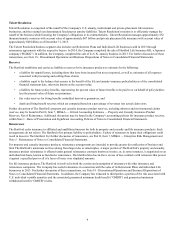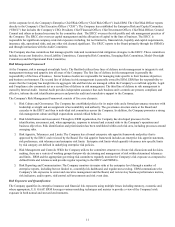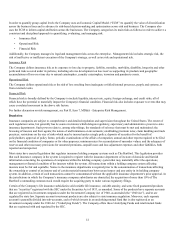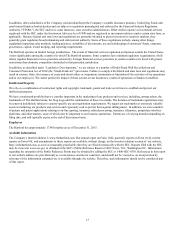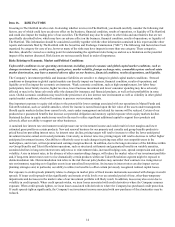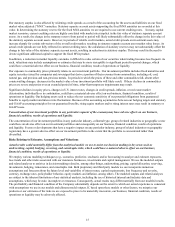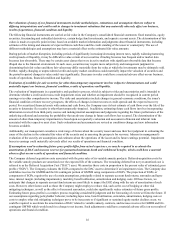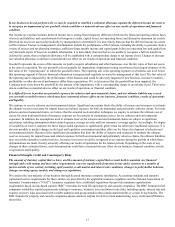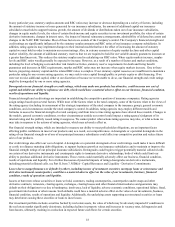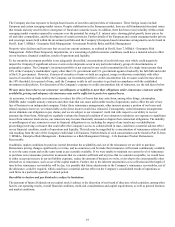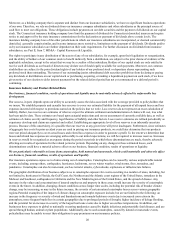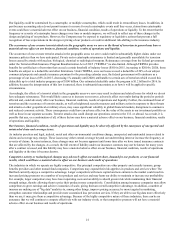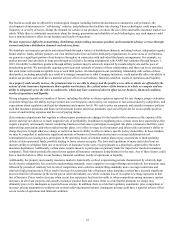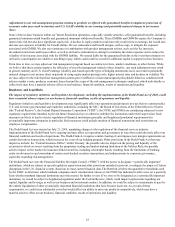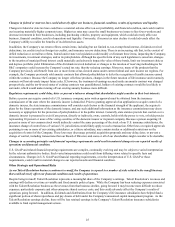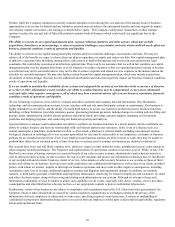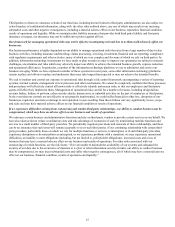The Hartford 2015 Annual Report Download - page 17
Download and view the complete annual report
Please find page 17 of the 2015 The Hartford annual report below. You can navigate through the pages in the report by either clicking on the pages listed below, or by using the keyword search tool below to find specific information within the annual report.17
If our businesses do not perform well, we may be required to establish a valuation allowance against the deferred income tax asset or
to recognize an impairment of our goodwill, which could have a material adverse effect on our results of operations and financial
condition.
Our income tax expense includes deferred income taxes arising from temporary differences between the financial reporting and tax bases
of assets and liabilities and carryforwards for foreign tax credits, capital losses, net operating losses and alternative minimum tax credits.
Deferred tax assets are assessed periodically by management to determine if it is more likely than not that the deferred income tax assets
will be realized. Factors in management's determination include the performance of the business, including the ability to generate, from a
variety of sources and tax planning strategies, sufficient future taxable income and capital gains before net operating loss and capital loss
carryforwards expire. If based on available information, it is more likely than not that we are unable to recognize a full tax benefit on
deferred tax assets, then a valuation allowance will be established with a corresponding charge to net income (loss). Charges to increase
our valuation allowance could have a material adverse effect on our results of operations and financial condition.
Goodwill represents the excess of the amounts we paid to acquire subsidiaries and other businesses over the fair value of their net assets
at the date of acquisition. We test goodwill at least annually for impairment. Impairment testing is performed based upon estimates of the
fair value of the “reporting unit” to which the goodwill relates. The reporting unit is the operating segment or a business one level below
that operating segment if discrete financial information is prepared and regularly reviewed by management at that level. The fair value of
the reporting unit is impacted by the performance of the business and could be adversely impacted if new business, customer retention,
profitability or other drivers of performance differ from expectations. If it is determined that the goodwill has been impaired, the
Company must write down the goodwill by the amount of the impairment, with a corresponding charge to net income (loss). These write
downs could have a material adverse effect on our results of operations or financial condition.
It is difficult for us to predict our potential exposure for asbestos and environmental claims, and our ultimate liability may exceed
our currently recorded reserves, which may have a material adverse effect on our business, financial condition, results of operations
and liquidity.
We continue to receive asbestos and environmental claims. Significant uncertainty limits the ability of insurers and reinsurers to estimate
the ultimate reserves necessary for unpaid losses and related expenses for both environmental and particularly asbestos claims. For some
asbestos and environmental claims, we believe that the actuarial tools and other techniques we employ to estimate the ultimate cost of
claims for more traditional kinds of insurance exposure are less precise in estimating reserves for our asbestos and environmental
exposures. In addition, the assumptions used to estimate reserves for asbestos and environmental claims are subject to significant
uncertainty, including assumptions about claim frequency, average severity and how insurance coverage applies. Accordingly, the degree
of variability of reserve estimates for these longer-tailed exposures is significantly greater than for other more traditional exposures. It is
also not possible to predict changes in the legal and legislative environment and their effect on the future development of asbestos and
environmental claims. Because of the significant uncertainties that limit the ability of insurers and reinsurers to estimate the ultimate
reserves necessary for unpaid losses and related expenses for both environmental and particularly asbestos claims, the ultimate liabilities
may exceed the currently recorded reserves. Increases in reserves would be recognized as an expense during the periods in which these
determinations are made, thereby adversely affecting our results of operations for the related periods. Depending on the scale of any
changes in these estimated losses, such determinations could have a material adverse effect on our business, financial condition, results
of operations and liquidity.
Financial Strength, Credit and Counterparty Risks
The amount of statutory capital that we have, and the amount of statutory capital that we must hold to maintain our financial
strength and credit ratings and meet other requirements, can vary significantly from time to time and is sensitive to a number of
factors outside of our control, including equity market, credit market and interest rate conditions, changes in policyholder behavior,
changes in rating agency models, and changes in regulations.
We conduct the vast majority of our business through licensed insurance company subsidiaries. Accounting standards and statutory
capital and reserve requirements for these entities are prescribed by the applicable insurance regulators and the National Association of
Insurance Commissioners (“NAIC”). Insurance regulators have established regulations that provide minimum capitalization
requirements based on risk-based capital (“RBC”) formulas for both life and property and casualty companies. The RBC formula for life
companies establishes capital requirements relating to insurance, business, asset and interest rate risks, including equity, interest rate and
expense recovery risks associated with variable annuities and group annuities that contain death benefits or certain living benefits. The
RBC formula for property and casualty companies adjusts statutory surplus levels for certain underwriting, asset, credit and off-balance
sheet risks.




